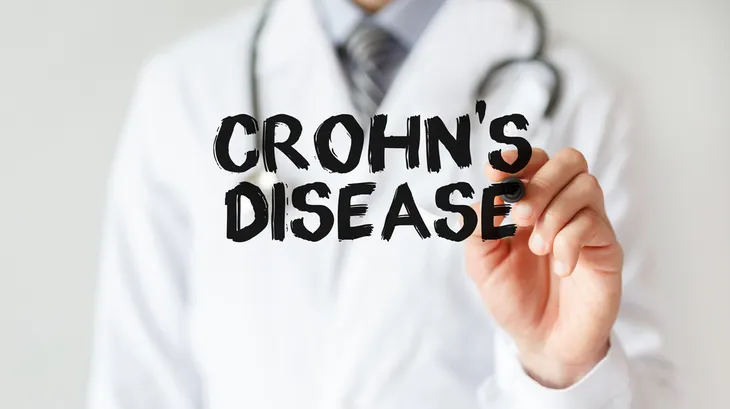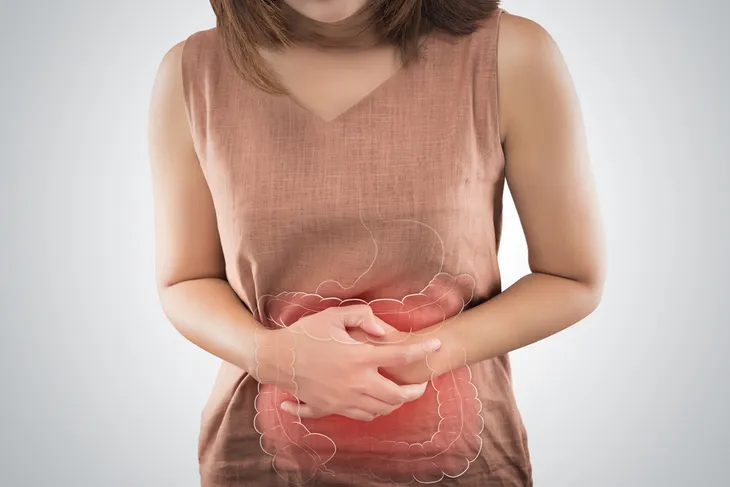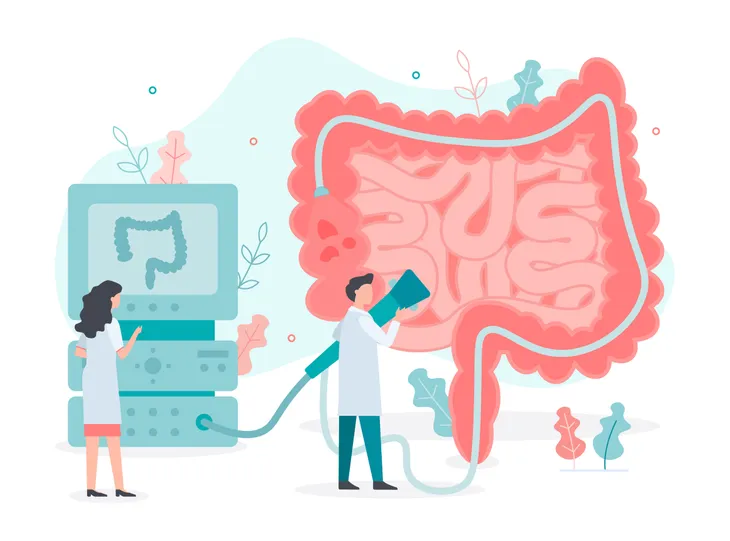- Both ulcerative colitis and Crohn’s disease are types of inflammatory bowel disease.
- While they may share some similarities, there are a few key differences that set them apart.
- Unfortunately, both conditions are incurable, however, there are treatment options available that can help you manage the condition and hopefully improve your symptoms.
There is nothing fun about dealing with digestive issues. Ulcerative colitis and Crohn’s disease sufferers know the symptoms all too well from diarrhea and abdominal cramping to fatigue and fever, and more. While both of these conditions are forms of inflammatory bowel disease and are characterized by chronic inflammation, there are some key differences that set them apart.
If you’re dealing with digestive problems, it’s important that you talk to your doctor for a proper diagnosis and treatment plan. In the meantime, here’s what you should know about ulcerative colitis vs Crohn’s disease, including their similarities, key differences, and treatment options.
What Is Ulcerative Colitis?
Ulcerative colitis is a type of inflammatory bowel disease (IBD), explains the Mayo Clinic. It causes inflammation and ulcers in your digestive tract and “affects the innermost lining of your large intestine (colon) and rectum,” explains the source.
Ulcerative colitis can cause rather uncomfortable and painful symptoms that typically develop gradually, rather than suddenly. The source also notes that it can lead to debilitating and in some cases, life-threatening complications so it’s important to get informed. Currently, there is no cure, however, there are treatments available to help you manage the disease.
Types of Ulcerative Colitis
Ulcerative colitis can be categorized into different types, depending on its location. The following types of ulcerative colitis include:
- Pancolitis: a type that affects the entire colon and causes bloody diarrhea, abdominal pain, fatigue, and significant weight loss.
- Ulcerative proctitis: a type that causes inflammation to the rectum which can result in rectal bleeding.
- Left-sided colitis: is a type that causes inflammation from the rectum, through the sigmoid and down to the colon. Common symptoms include pain and cramping on the left side, bloody diarrhea, and an urgency to have a bowel movement.
- Proctosigmoiditis: is a type that causes inflammation in the rectum and sigmoid colon. Bloody diarrhea, abdominal pain, and constipation are common signs of this type.
Symptoms of Ulcerative Colitis
Your symptoms will vary depending on the type of ulcerative colitis you have, including where the inflammation is located. That said, some common symptoms of ulcerative colitis may include bouts of diarrhea (sometimes with blood or pus), rectal pain or bleeding, and abdominal pain and cramping.
Fatigue, fever, and weight loss are also possible symptoms. As is an urgency to defecate or constipation despite the urgency. The severity of the symptoms can vary from mild to moderate and some individuals may experience long periods of remission, says the Mayo Clinic.
What Is Crohn’s Disease
Crohn’s disease is another type of inflammatory bowel disease (IBD). Like ulcerative colitis, Crohn’s also causes inflammation in your digestive tract. “Inflammation caused by Crohn’s disease can involve different areas of the digestive tract in different people,” explains the Mayo Clinic. The source also notes that the inflammation typically spreads into deeper layers of the bowel.
Crohn’s disease can also be debilitating and in some cases, it may lead to life-threatening complications. And just like ulcerative colitis, there is currently no cure. Luckily, certain treatments can help you manage the disease and may even “bring about long-term remission and healing of inflammation,” says the source.
 Shutterstock/Michail Petrov
Shutterstock/Michail PetrovSymptoms of Crohn’s Disease
Crohn’s disease can affect your small or large intestine. The Mayo Clinic explains, “it may be continuous or may involve multiple segments. In some people, the disease is confined to the colon, which is part of the large intestine.”
Symptoms of Crohn’s disease are similar to ulcerative colitis including diarrhea, fever, fatigue, and abdominal cramping and pain. You may also experience bloody stool, weight loss, and mouth sores. The source also notes that individuals with severe Crohn’s disease may develop kidney stones; anemia (an iron deficiency); and inflammation of the skin, eyes, joints, liver, or bile ducts.
How Are They Similar?
Ulcerative colitis and Crohn’s disease are similar in a few ways. For starters, they’re both types of IBD and both cause chronic inflammation in the digestive tract. They also share many similar symptoms which is why you shouldn’t try to self-diagnose. It’s important that you see your doctor for a proper diagnosis.
Both diseases commonly affect teens and young adults, however, they can also develop at any age. The disease also affects men and women equally, says UCLA Health. The source also notes, “both diseases have similar types of contributing factors such as environmental, genetic and an inappropriate response by the body’s immune system.”
Key Differences: The Symptoms
While the two diseases are similar, there are also a few notable differences that set them apart including some of their symptoms and where the inflammation develops. Only a health professional will be able to determine which type of IBD you have, so it’s important to explain all your symptoms to your doctor or GI specialist.
While their symptoms may seem similar on the surface, Everyday Health points out that ulcerative colitis is mostly characterized by blood stool with mucus and frequent diarrhea, whereas Crohn’s disease is “often marked by nausea, weight loss, and vomiting, with only occasional rectal bleeding, and diarrhea.” Crohn’s can also cause mouth sores, or inflammation of the skin, joints, and eyes which are not symptoms of ulcerative colitis.
Key Differences: Where the Inflammation Develops
Another important difference between ulcerative colitis and Crohn’s disease is where the inflammation develops. Ulcerative colitis is isolated to the colon, whereas inflammation can develop anywhere between the mouth and the anus in Crohn’s disease, explains UCLA Health.
The source also notes that ulcerative colitis causes continuous inflammation in the colon, whereas in Crohn’s disease, “there are healthy parts of the intestine mixed in between inflamed areas.” Finally, Crohn’s disease develops in all layers of the bowel walls and ulcerative colitis only affects the innermost lining of the colon.
Causes
The exact cause of both ulcerative colitis and Crohn’s disease is, unfortunately, unknown. That said, certain factors may play a role in increasing your risk for developing one of the diseases.
The Mayo Clinic says, your family history may increase your risk for developing both ulcerative colitis and Crohn’s disease. If you have immediate family members with the disease, you may be more likely to develop it too. Having a virus or bacterium may also trigger Crohn’s disease, however, “scientists have yet to identify such a trigger,” says the source.
Furthermore, age may play a role in ulcerative colitis. The Mayo Clinic says it typically begins before the age of 30, however, it can develop at any age. If you’re concerned about your risk of developing one of these diseases, talk to your doctor.
When to See a Doctor
Both ulcerative colitis and Crohn’s disease can cause unsightly and painful symptoms. After all, it’s always alarming to see blood in the stool. The symptoms can even be debilitating, affecting your daily activities.
If you develop any of the symptoms of either disease, contact your doctor right away. Healthline also says, “IBD can even lead to scar tissue and increase the risk of colon cancer.” All the more reason to see your doctor!
During your visit, your doctor will likely start by reviewing your medical history and asking you about your symptoms. If they suspect you may have an IBD they may refer you to a gastroenterologist for testing.
Diagnosing Ulcerative Colitis and Crohn’s Disease
If your doctor suspects you may have one of these diseases, they will likely request a colonoscopy, says Everyday Health. This involves inserting a thin tube with a camera into the colon and allows your doctor to see the colon as well as take a biopsy of the inflamed tissue.
During the colonoscopy, if your doctor sees continuous inflammation from the rectum to the colon and then stops, this could be a key sign that you have ulcerative colitis. On the other hand, if your doctor sees patches of healthy tissue mixed with patches of inflamed tissue, this may indicate Crohn’s disease. Other possible tests include sigmoidoscopy; blood, and fecal testing; and computed tomography (CT) scan.
Treating Ulcerative Colitis and Crohn’s Disease
Although there is no cure for ulcerative colitis and Crohn’s disease, there are treatments available that can help you manage the condition and hopefully improve your symptoms. Both diseases are typically treated using drug therapy or surgery.
The type of medications you need will depend on the severity of the condition. The Mayo Clinic says one goal of treatment is to help reduce inflammation that triggers your system and another goal is to “improve long-term prognosis by limiting complications.”
Keep in mind, the source says “there is no single treatment that works for everyone.” One medication that works well for others may not work for you, which is why it’s vital that you work closely with your doctor.














